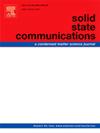了解印楝叶提取物介导的MgO8V3纳米泡芙的退火效果及其对靛蓝胭脂红光催化的不利影响
IF 2.4
4区 物理与天体物理
Q3 PHYSICS, CONDENSED MATTER
引用次数: 0
摘要
绿色路线合成纳米材料具有重要的意义,因为绿色物质中含有丰富的还原、氧化、封盖和生长聚合物。本研究首次以印楝叶提取物为天然燃料,采用简单的溶胶-凝胶法在控制温度(300、400、500℃)下获得具有独特纳米泡状形貌的MgO8V3纳米材料。采用XRD、SEM、EDX、光电流响应和FT-IR分析技术对合成的MgO8V3纳米材料进行了分析。P-XRD证实了MgO8V3(500℃)的单斜晶型结构。MgO8V3(500°C)表现出纳米泡状形态,是降解有害靛蓝胭脂(InC)染料的有希望的候选材料,效率为99.28%,速率为0.0287 min−1。相比之下,在500°C退火的MgO8V3由于其形貌表现出高度的降解,导致入射光的高吸光度,导致电荷复合减少,能带结构取向改善。本文章由计算机程序翻译,如有差异,请以英文原文为准。
Understand the annealing effect of MgO8V3 nano-puffs derived from Azadirachta indica leaves extract mediated: its adverse impact on the photocatalysis of Indigo carmine
Green route synthesis of nanomaterials has gained significance due to rich sources of reducing, oxidizing, capping, and growth polymers in greenery substances. This investigation reports a novel eco-friendly method to obtain MgO8V3 nanomaterial with unique nano-puff-like morphology at controlled temperatures (300, 400, 500 °C) by a simple sol-gel method for the first time by a green approach using Azadirachta indica leaves extract as a natural fuel. The synthesized MgO8V3 nanomaterial was analyzed using XRD, SEM, EDX, photocurrent response and FT-IR analytical techniques. The monoclinic crystal structure of MgO8V3 (500 °C) was confirmed by P-XRD. MgO8V3 (500 °C) exhibits nano-puff-like morphology, which is a promising candidate for the degradation of hazardous Indigo Carmine (InC) dye with 99.28 % efficiency, having a rate of 0.0287 min−1. Comparatively, MgO8V3 annealed at 500 °C showed a high degree of degradation due to its morphology, causing high absorbance of incident light, leading to reduced charge recombination and improved band structure alignment.
求助全文
通过发布文献求助,成功后即可免费获取论文全文。
去求助
来源期刊

Solid State Communications
物理-物理:凝聚态物理
CiteScore
3.40
自引率
4.80%
发文量
287
审稿时长
51 days
期刊介绍:
Solid State Communications is an international medium for the publication of short communications and original research articles on significant developments in condensed matter science, giving scientists immediate access to important, recently completed work. The journal publishes original experimental and theoretical research on the physical and chemical properties of solids and other condensed systems and also on their preparation. The submission of manuscripts reporting research on the basic physics of materials science and devices, as well as of state-of-the-art microstructures and nanostructures, is encouraged.
A coherent quantitative treatment emphasizing new physics is expected rather than a simple accumulation of experimental data. Consistent with these aims, the short communications should be kept concise and short, usually not longer than six printed pages. The number of figures and tables should also be kept to a minimum. Solid State Communications now also welcomes original research articles without length restrictions.
The Fast-Track section of Solid State Communications is the venue for very rapid publication of short communications on significant developments in condensed matter science. The goal is to offer the broad condensed matter community quick and immediate access to publish recently completed papers in research areas that are rapidly evolving and in which there are developments with great potential impact.
 求助内容:
求助内容: 应助结果提醒方式:
应助结果提醒方式:


